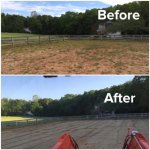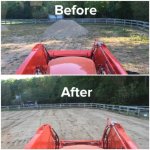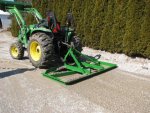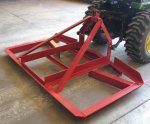Hey guys. I recently had a horse riding ring job. The customer wanted their 15,000 square foot riding rink re-sanded. I just completed the job yesterday. I had 7 dump truck loads (15 yds each) of sand brought in and dump in different locations around the ring. I used my FEL to spread the sand in straight rows then I put my bucket in float mode and backed up dragging the bucket which helped flatten the sand. It worked ok but wasn't as level as I had hoped. Although the homeowner was pleased with the results, I thought to myself, I could have done a better job at leveling the sand. I also have a 6' scrape blade that weights about 600 lbs. I tried turning it around backwards and dragging it. It actually did a worse job than using my bucket. Just left too many humps (high and lows) behind.
I updated my Craigslist tractor service add this week to include horse rings and have actually got two more calls to do horse rings nearly double the size of this first one I just did. Is there a better 3 point implement for smoothing and spreading sand? Any advice is greatly appreciated.
Here are some before and after shots of the riding ring.


I updated my Craigslist tractor service add this week to include horse rings and have actually got two more calls to do horse rings nearly double the size of this first one I just did. Is there a better 3 point implement for smoothing and spreading sand? Any advice is greatly appreciated.
Here are some before and after shots of the riding ring.










